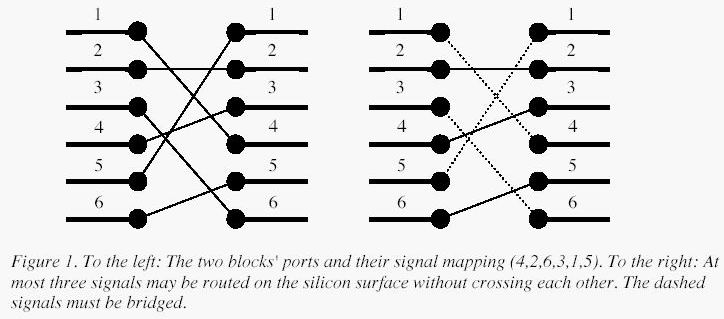| Time Limit: 1000MS | Memory Limit: 10000K | |
| Total Submissions: 14226 | Accepted: 7696 |
Description
'Oh no, they've done it again', cries the chief designer at the Waferland chip factory. Once more the routing designers have screwed up completely, making the signals on the chip connecting the ports of two functional
blocks cross each other all over the place. At this late stage of the process, it is too expensive to redo the routing. Instead, the engineers have to bridge the signals, using the third dimension, so that no two signals cross. However, bridging is a complicated
operation, and thus it is desirable to bridge as few signals as possible. The call for a computer program that finds the maximum number of signals which may be connected on the silicon surface without crossing each other, is imminent. Bearing in mind that
there may be thousands of signal ports at the boundary of a functional block, the problem asks quite a lot of the programmer. Are you up to the task?

A typical situation is schematically depicted in figure 1. The ports of the two functional blocks are numbered from 1 to p, from top to bottom. The signal mapping is described by a permutation of the numbers 1 to p in the form of a list of p unique numbers in the range 1 to p, in which the i:th number specifies which port on the right side should be connected to the i:th port on the left side.Two signals cross if and only if the straight lines connecting the two ports of each pair do.

A typical situation is schematically depicted in figure 1. The ports of the two functional blocks are numbered from 1 to p, from top to bottom. The signal mapping is described by a permutation of the numbers 1 to p in the form of a list of p unique numbers in the range 1 to p, in which the i:th number specifies which port on the right side should be connected to the i:th port on the left side.Two signals cross if and only if the straight lines connecting the two ports of each pair do.
Input
On the first line of the input, there is a single positive integer n, telling the number of test scenarios to follow. Each test scenario begins with a line containing a single positive integer p < 40000, the number of
ports on the two functional blocks. Then follow p lines, describing the signal mapping:On the i:th line is the port number of the block on the right side which should be connected to the i:th port of the block on the left side.
Output
For each test scenario, output one line containing the maximum number of signals which may be routed on the silicon surface without crossing each other.
Sample Input
4 6 4 2 6 3 1 5 10 2 3 4 5 6 7 8 9 10 1 8 8 7 6 5 4 3 2 1 9 5 8 9 2 3 1 7 4 6
Sample Output
3 9 1 4
Source
Regionals 2003 >> Europe - Northwestern
问题链接:UVALive2931 POJ1631 HDU1950 Bridging signals。
问题简述:参见上述链接。
问题分析:最长上升子序列问题。
程序说明:程序改写了一版,使用C语言的输入输出函数,不然POJ1631会TLE(超时)。留下原有程序,有个比较。
题记:(略)
AC的C++语言程序如下:
/* UVALive2931 POJ1631 HDU1950 Bridging signals */
#include <iostream>
#include <stdio.h>
using namespace std;
const int N = 40000;
int stack[N+1], ps;
int main()
{
int t, n, val;
scanf("%d", &t);
while(t--) {
scanf("%d", &n);
ps = 0;
for(int i=1; i<=n; i++) {
scanf("%d", &val);
int left=1, right=ps, mid;
while(left <= right) {
mid = (left + right) / 2;
if(val > stack[mid])
left = mid + 1;
else
right = mid - 1;
}
stack[left] = val;
ps = max(ps, left);
}
printf("%d
", ps);
}
return 0;
}AC的C++语言程序如下:
/* UVALive2931 POJ1631 HDU1950 Bridging signals */
#include <iostream>
using namespace std;
const int N = 40000;
int stack[N+1], ps;
int main()
{
int t, n, val;
cin >> t;
while(t--) {
cin >> n;
ps = 0;
for(int i=1; i<=n; i++) {
cin >> val;
int left=1, right=ps, mid;
while(left <= right) {
mid = (left + right) / 2;
if(val > stack[mid])
left = mid + 1;
else
right = mid - 1;
}
stack[left] = val;
ps = max(ps, left);
}
cout << ps << endl;
}
return 0;
}